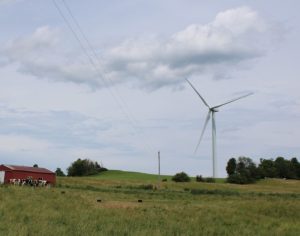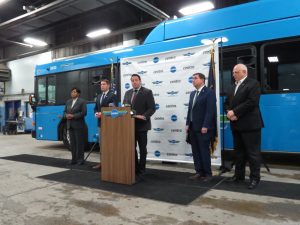ONONDAGA — After more than 17 years, Covanta Energy is still turning Onondaga County’s trash into the electricity grid’s power. Morristown, N.J.–based Covanta (NYSE: CVA) operates the energy-from-waste Onondaga County Resource Recovery Facility at 5801 Rock Cut Road in the town of Onondaga through its Covanta Onondaga, LP subsidiary. The 39,000-square-foot facility takes the nonhazardous […]
Get Instant Access to This Article
Become a Central New York Business Journal subscriber and get immediate access to all of our subscriber-only content and much more.
- Critical Central New York business news and analysis updated daily.
- Immediate access to all subscriber-only content on our website.
- Get a year's worth of the Print Edition of The Central New York Business Journal.
- Special Feature Publications such as the Book of Lists and Revitalize Greater Binghamton, Mohawk Valley, and Syracuse Magazines
Click here to purchase a paywall bypass link for this article.
 ONONDAGA — After more than 17 years, Covanta Energy is still turning Onondaga County’s trash into the electricity grid’s power.
ONONDAGA — After more than 17 years, Covanta Energy is still turning Onondaga County’s trash into the electricity grid’s power.
Morristown, N.J.–based Covanta (NYSE: CVA) operates the energy-from-waste Onondaga County Resource Recovery Facility at 5801 Rock Cut Road in the town of Onondaga through its Covanta Onondaga, LP subsidiary. The 39,000-square-foot facility takes the nonhazardous trash from nearly all of Onondaga County and burns it to generate electricity. Covanta uses some of that electricity to run the facility, while selling the rest to the power company National Grid (NYSE: NGG).
“Anything that doesn’t go in the blue bin goes here,” says Kathleen Carroll, Covanta Onondaga business manager. “About 90 percent of our power goes to the grid, and we power about 32,000 homes in Onondaga County.”
The Onondaga facility generates up to 39.5 MW of power. It can burn up to 361,350 tons of waste a year — 990 tons per day. Covanta estimates its power production over the last 10 years has prevented 5.5 million barrels of oil from needing to be burned to produce electricity.
However, amid the difficult economy, the energy-from-waste plant is currently operating at about 20 percent below capacity. It hasn’t burned near capacity levels since 2007, when it came within 6,000 tons of incinerating its annual limit.
That doesn’t have Covanta rethinking a relationship with the Onondaga County Resource Recovery Agency (OCRRA) under which it operates the plant, according to Carroll.
“We just want to continue the successful joint operations,” she says. “It’s worked well for 17 years.”
Covanta and OCRRA co-own the energy-from-waste facility, according to Mark Donnelly, OCRRA’s executive director. The two entities share its revenue.
OCRRA generated just under $7.6 million in revenue in 2011 from electricity sales, according to its 2011 annual report. It budgeted for energy-from-waste sale revenue of slightly under $8.1 million in 2012, its 2012 annual operating budget summary shows.
Covanta operates 44 energy-from-waste facilities worldwide and 40 in North America. The company does not break down revenue generation between its different locations, but it generated a total of $400 million from electricity and steam sales in 2011, according to that year’s annual report. That’s down from $420 million in 2010.
Donnelly doesn’t expect the Onondaga waste-from-energy plant’s capacity to stay low forever. If consumers pick up their rate of purchasing consumer goods, the county will start generating more trash, he says.
“Right now we’re not at full capacity,” Donnelly says. “And that’s because of the economic downturn. With consumption low, tonnage is low.”
In addition to generating energy, burning trash keeps material out of landfills, according to Covanta. Burned trash is reduced in volume by about 90 percent, the company says.
The remaining 10 percent is ash that landfills can use as daily cover in place of other covers like soil, says Stan Longo, facility manager of the Onondaga plant. The facility also pulls metal out of the ash before sending it to landfills, he says.
“We’ll do roughly 8,000 tons of ferrous and 450 tons of nonferrous recovery annually,” he says. “The ferrous metal is recovered by a big drum magnet. The nonferrous, we have an eddy-current system that captures mainly aluminum.”
Recovered metal is sold to processing facilities for recycling and use in new products, Longo adds.
The energy-from-waste plant uses a continuous monitoring system to make sure it remains within emissions standards, according to Longo. The facility uses acid and gas scrubbers, a bag house, and cleaning technologies to prevent contaminants like hydrogen chloride, hydrogen fluoride, sulfur dioxide, and mercury from making it into the air, he says.
Covanta employs 46 people at the Onondaga facility, which won the 2012 Gold Excellence Award from the Solid Waste Association of North America for environmentally and economically sound waste management. It has operated the plant almost every day of each year since it opened for commercial operation in February 1995.
“Twice a year you have boiler outages on each of the three units,” Longo says. “And then every two to three years you have a total plant [shutdown] just to do work on steam systems that you can’t do online.”
Contact Seltzer at rseltzer@cnybj.com



